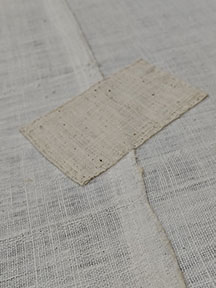‘ पैबंद ‘
by Avani Varia (2025)
Step into a story woven with threads of resilience, simplicity, and silent strength.
“Paibandh”—meaning patch—is often seen as a visible mark of poverty, a humble stitch that speaks of scarcity, struggle, and worn-out garments mended to last just a little longer. It’s a symbol many have looked down upon, a reminder of hardships endured. But in this evocative artwork by Avani, it becomes a powerful symbol of dignity, pride, and purpose—transforming hardship into strength. Today, the Gen Z embraces patch as a subtle yet meaningful fashion statement.
Inspired by the lives of Sardar Vallabhbhai Patel and his daughter Manibahen, this piece invites you to reflect on a lesser-seen side of India’s freedom movement. Manibahen spun cotton on a Peti Retiyo (traditional spinning wheel, Box Charkha), and together, they wore garments hand-woven with her handspun yarn with love and intention. They wore it with pride—a quiet rebellion, a visible commitment to Swadeshi, Swarajya, and self-reliance.
Through Paibandh, Avani reclaims the meaning of the patch—not as a flaw, but as a powerful statement. It honors those who chose simplicity over show, values over vanity, and who saw in every thread a step toward freedom.
This is more than art; it is memory, message, and movement—spun, woven, stitched and printed together with heart.
The following Hindi excerpt is part of Varia’s research—an incident that deeply inspired this artwork. Moved by its spirit, she spun the threads herself on a Box Charkha, weaving them into 100% handmade Khaddar (Khadi) fabric. Using techniques like patchwork and print transfer, she brings this story to life—layered with meaning, memory, and craftsmanship.
Through this work the Artist hopes to inspire people today to rediscover and embrace the values of Swadeshi—choosing local, living mindfully, and finding pride in simplicity and self-reliance.
सरदार पटेल और मणिबहन की स्वदेशी के प्रति निष्ठा
मणिबहन अपने पिताजी को दवाई पीला रही थीं । तभी महावीर त्यागीजी की नज़र उनकी सादी, स्पष्ट रूप से घिसी हुई और सावधानी से पैबंद लगी खादी की साड़ी पर पड़ी । पैबंद को देखकर उन्होंने मणिबहनकी हँसी करते हुए कहा, “इतने बड़े नेता की बेटी होकर भी पैबंद लगी साड़ी पहनती हो ? तुम्हें शर्म नहीं आती?” उस समय (१९४९) सरदार वल्लभभाई पटेल भारत के उप-प्रधानमंत्री और गृह मंत्री के रूप में सेवा दे रहे थे।
मणिबहनने बिगडकर जवाब दिया …… जो लोग गलत और अन्यायपूर्ण तरीकों से धन कमाते हैं, उन्हें शर्म आनी चाहिए। मैं अपने श्रम से बनाए कपड़े पहनकर, अपने वैध कर्तव्यों का पालन करती हु। जो लोग अपने माता-पिता की कमाई को अपनी सुख-सुविधाओं में फिजूल खर्च करते हैं, उन्हें स्वयं पर शर्म होनी चाहिए। अपने वृद्ध पिता की सेवा करते हुए, मैं अपने चुने हुए कपड़े पहनकर अपना कार्य करती हूँ। मैं अपनी गरिमा और आत्म-सम्मान बनाए रखना जानती हूँ, और मुझे अपने आचरण का तरीका किसीसे सीखने की आवश्यकता नहीं है। मुझे किसी बात पर शर्मिंदगी नहीं है।
तब डॉ. सुशीला नायर, जो वहाँ थीं, उन्होंने बताया कि मणिबहन रोज़ चरखा कातती हैं और उसी सूत से सरदार पटेलके और अपने कपड़े बनाती हैं। १९२१ में जबसे सरदार पटेल ने केवल स्वदेशी पहनने का संकल्प लिया, तबसे लेकर जीवनपर्यंत उनके वस्त्र मणिबहन द्वारा स्वयं काते गए सूत से बने होते थे। सरदार साहब कभी खादी भंडार से कपड़ा नहीं खरीदते। उनके पुराने कुर्ते और धोतियों जो घिस जाते हे उनको मणिबहन काटकर अपने साड़ी-कुर्ता बनाति हैं।
यह पैबंद केवल कपड़े की मरम्मत नहीं, बल्कि आत्मनिर्भरता, सादगी और स्वदेशी संकल्प का सजीव प्रतीक था जो मणिबहन और सरदार की इस घटना के माध्यम से हमें सिखाता है कि सच्चा राष्ट्रप्रेम अपने जीवन में स्वदेशी और मितव्ययी जीवनशैली को अपनाने में है।
*खादी हाथ से काती और हाथ से बुनी जाती है। खादी केवल १००% हस्तनिर्मित कपड़ा ही नहीं, बल्कि एक जीवनशैली है — स्वदेशी सिद्धांतों और श्रम की गरिमा के प्रति एक प्रतिबद्धता।
The Art first exhibited as part of the Group show – ‘Resonance: Sardar • Navajivan • The Artist’s Eye’ – at Satya Art Gallery, Ahmedabad from 31 Oct to 15 Dec 2025 – Artwork video will be shared here soon… meanwhile click here






